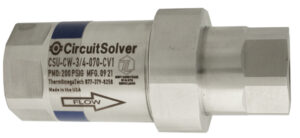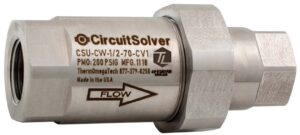Legionnaires’ Disease Prevention: Risk Mitigation with Thermostatic Balancing Valves
News headlines about Legionnaires’ disease outbreaks are a stark reminder of a critical public health challenge that often originates within the very water systems of our commercial, institutional, and residential buildings.

Legionnaires’ disease, a severe form of pneumonia, is caused by Legionella bacteria, which thrive in specific conditions found in complex plumbing systems.
When cold water flow is minimal or stopped altogether, disinfectant levels evaporate, and temperatures gradually rise to the Legionella growth range (77–113°F, 25–42°C), leading to bacterial colonization and uneven free chlorine distribution throughout the system.
Understanding how these bacteria flourish in various parts of a building’s water infrastructure and how to prevent their growth proactively is crucial for safeguarding public health and ensuring compliance.
Understanding the Threat of Legionnaires’ Disease
Legionnaires’ disease is a severe lung infection contracted by inhaling small droplets of water (aerosols) contaminated with Legionella bacteria. Various building water systems, including showers and faucets, can generate these aerosols. It’s important to note that Legionnaires’ disease is not spread person-to-person.
Symptoms can range from mild to severe, including cough, shortness of breath, high fever, muscle aches, and headaches. While some individuals recover, Legionnaires’ disease can be fatal, particularly for those with weakened immune systems or chronic lung conditions. The severity and public impact of outbreaks underscore the critical need for effective and proactive prevention strategies.
The Critical Role of Balanced Recirculation
Recirculating cold water eliminates stagnation, which promotes harmful bacteria growth, and provides consistent distribution of residual chlorine throughout domestic cold-water systems:
- Keeps water moving
- Maintains water quality to reduce stagnation
- Ensures residual chlorine is distributed throughout the cold-water system
- Keeps water temperature in branches and risers evenly distributed, minimizing heat gain
How Thermostatic Technology Changes the Game
Implementing effective recirculation, particularly in large and complex plumbing systems, requires precision to ensure adequate flow to all branches without creating significant water waste or manual balancing. This is where self-actuating thermostatic valve technology comes into play.
How the CircuitSolver® CSU-CW Valve Works
The CircuitSolver® Union Cold Water valve, using innovative automatic thermal balancing technology, offers a robust solution for optimizing cold water recirculation loops, ensuring optimal conditions for Legionella control.
The CSU-CW valve utilizes the same reliable and precise thermal actuator technology as the original CircuitSolver®. It addresses critical issues related to Legionella mitigation in cold water recirculation systems by maintaining a stable temperature. It accomplishes this by continuously monitoring the water temperature and modulating flow to maintain a set temperature at the end of each branch or riser.
The valve operates over a 10°F temperature range. For example, a valve specified for a desired return temperature of 60°F will open at 70°F (10°F above the desired return temperature). At 60°F, the valve is in its closed position. A bypass in the design always allows water to flow back to the pump so that the pump is never dead-headed.
The CircuitSolver® Difference
Simplified Design & Operation
Unlike manual balancing valves that require extensive, often inexact, commissioning and re-balancing, automatic valves like CircuitSolver® provide continuous, dynamic balancing. This eliminates the need for manual adjustments, saving time and labor while ensuring optimal, ongoing system performance.
Enhanced Efficiency
By intelligently directing flow only where needed, CircuitSolver® thermostatic balancing valves maximize the effectiveness of the recirculation system, leading to both safety and cost savings.
Mitigate Legionella with Thermostatic Technology
By taking a proactive, comprehensive approach to Legionella control and utilizing advanced technology like CircuitSolver’s automatic thermal balancing valves, you can transform your building’s water system from a potential risk into a safe, reliable, and compliant resource, mitigating Legionella bacteria.
Find more information about our thermostatic balancing valves here.

